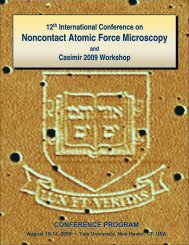Circuit Quantum Electrodynamics - Yale School of Engineering ...
Circuit Quantum Electrodynamics - Yale School of Engineering ...
Circuit Quantum Electrodynamics - Yale School of Engineering ...
You also want an ePaper? Increase the reach of your titles
YUMPU automatically turns print PDFs into web optimized ePapers that Google loves.
CHAPTER 1. INTRODUCTION 21<br />
|1〉<br />
|0〉<br />
E = h f<br />
Figure 1.1: a. Any two quantum energy levels can be used as a qubit. Relaxation occurs when the<br />
qubit decays from the excited state to the ground state. b. When in a superposition, the phase, φ,<br />
<strong>of</strong> the qubit precesses at a frequency determined by the energy difference between the two levels. If<br />
this energy varies in time, the clock speed will vary causing it to lose time or dephase.<br />
is the bane <strong>of</strong> most would-be qubits (see Fig. 1.1b). It is for this reason that there is an intimate<br />
relationship between the study <strong>of</strong> atomic clocks and quantum bits [Monroe1995].<br />
In order to prevent decoherence, this loss <strong>of</strong> quantum character, the elements <strong>of</strong> a quantum<br />
computer must both be isolated from sources <strong>of</strong> noise, and yet be strongly coupled to each other,<br />
all the while being controlled by the classical experimenter. These nearly antithetical requirements<br />
pose a shared challenge for all quantum computing experiments, and have stimulated the flow <strong>of</strong><br />
ideas among disciplines. In this project, we apply analogies <strong>of</strong> atomic physics to superconducting<br />
circuits, as a means <strong>of</strong> taming the large decoherence present in solid-state environments. Applying<br />
these analogies in reverse we use superconducting circuits to access areas difficult or impossible to<br />
study in natural atomic systems.<br />
1.2 Cavity <strong>Quantum</strong> <strong>Electrodynamics</strong><br />
The electromagnetic field, though it has a wave-like nature, is composed <strong>of</strong> discrete packets known<br />
as photons. At first glance, this seems like a rather innocuous postulate, a matter <strong>of</strong> bookkeeping<br />
rather than a qualitative shift from classical waves. This discretization, however, has subtle and far<br />
reaching effects, explaining many mysteries, including the color <strong>of</strong> a hot object such as our sun, and<br />
why excited atoms decay, emitting light only at certain frequencies. The complexities <strong>of</strong> the photon<br />
postulate become more apparent when asking even a simple question like, “What is the shape <strong>of</strong><br />
a photon?” The answer to this is subtle. Both the spatial and temporal distributions <strong>of</strong> energy<br />
are not fixed, but are dependent and controllable by the boundary conditions imposed upon the<br />
photon by matter. If a photon is so malleable how can it be discrete? How does matter interact<br />
B















